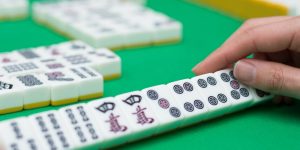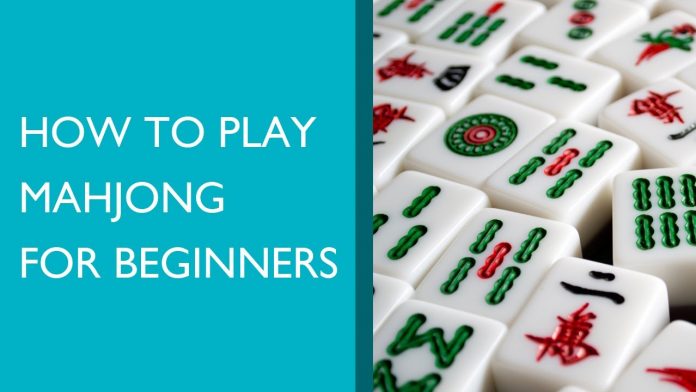How to play mahjong. Mahjong is a Chinese parlor game that four people usually play. There is no “one” binding rule, but several “genres” that are typically assigned to a region and possibly an era (e.g., “classical Chinese” or “modern Japanese” rules). Even within these groups, however, there is again a confusing number of variants; however, almost all variants have the following basic rules in common.
Game material

A Mah-Jongg set consists of 144 pieces (“bricks”), namely:
- 108 colored bricks, four identical bricks numbered from 1 to 9, i.e., 36 bricks in each of the three “colors” (suits):
- 8 bonus tiles in two distinguishable groups of four, often as four flower and four seasons each – these tiles are only available once, one tile of each of these two groups is assigned to one wind (east = 1 / spring / plum / fisherman, south = 2 / Summer / Orchid / Lily / Woodcutter, West = 3 / Autumn / Chrysanthemum / Farmer, North = 4 / Winter / Bamboo / Scholar)
Game pieces and target
Each player initially has 13 bricks “in hand,” draws another one, and, if he does not “finish” with it, throws down another brick. The goal is to create a complete final picture from 14 bricks: A steady final hand (“Mah-Jongg-Hand”) consists of four groups of three (three of a kind/pong or follow / chew) and one pair – a four of a kind (kong) can each replace a three of a kind (pong), giving you a spare tile, so that the total number of the final hand increases by one for each kong. Most of the game variants also have “irregular” closing hands that structure differently.
Preparation
The game starts in the “Ostwind Rude,” Each player assigns a “Platzwind.” Before starting, you determine the starting wind for each player, the easiest way to do this is by drawing lots with four hidden wind tiles. The players take their seats at an ideally square table according to their drawn wind. The sequence does not correspond to the usual wind rose but starts with the east and runs counterclockwise over south and west to north.
Construction and breakthrough of the wall
All bricks require for the respective game variant shuffle face down. If bonus blocks are in play, each player builds a wall 18 bricks wide in front of him and then a “second floor” – without bonus blocks, the wall is only 17 bricks wide. The four divisions then push together to form a square.
To ensure that no one can cheat during the construction and cobble together pleasant bricks, it determines at random from which point the game pieces distribute. The most diverse variants are known for the “breakthrough” of the wall. The easiest way is the east wind throws two dice and counts, starting with itself, counterclockwise.
Distribution of bricks
Unless the specific rule variant provides otherwise, each player takes, starting with the east wind, one after the other (counterclockwise!) Three times four bricks. Then the east wind takes the top tiles of the first and third pair of tiles (i.e., two tiles), and every other player takes another one (see sketch).
If you are playing with bonus tiles, each player, starting with the east wind, lays out the flowers and seasons in his hand open in front of him before the actual start of the game and takes a replacement tile from the end of the wall for each bonus tile (if you pull a bonus tile again, this immediately reveals and replace).
The course of the game: How to play mahjong
The east wind begins the game by placing an unneeded brick openly in the space between the walls (it has taken one more than the others). Depending on the rule variant, each player either places their discards separately in orderly rows or all of them deposit their discards there is a “wildly confused” manner.
Calls: How to play mahjong
Another player can claim (call) a brick that has just through. If he can use it to complete a pawn. To do this, the player reaches the name of the respective figure (Tschau, Pong. Kong, or Mah-Jongg / Majiang or Hu for the completed final picture). Shows the corresponding bricks from his hand. And reveals the figure formed with the called stone (reported) in front of you. A call breaks the typical sequence: The caller now throws down brick and continues from him in an anti-clockwise direction.
A discarded tile, which requires completing a Pong or Kong, can claim by any player. But a Tschau can only call by the player on the left (i.e., in turn, order).
Masked figures and kongs: How to play mahjong
Pieces that a player forms exclusively from bricks he has drawn from the wall “conceal. They usually stay hidden in hand until the end, resulting in a higher score than open groups. A Kong collected on the hand. However, has to lay out so that you can pick up a replacement tile. Depending on the rule variant, all or only two tiles lay out face down. In general, a kong laid out in this way counts as a face-down figure. And the entire hand continues to be face down. Unless the player has already laid out, other pieces face up.
Playing
If a player is missing only one last tile (possibly from several possible ones) for an excellent final picture. (Possibly including openly laid out pieces), his hand is called “waiting. If the last tile falls or the player draws it himself. He ends the game by shouting mah-jongg. And using the concrete rules or scoring tables to determine the number of points achieved.
Also Read: How to speed up your computer






